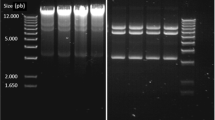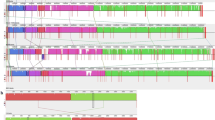Abstract
Lactobacillus gasseri LF221, an isolate from the feces of a child, produces two bacteriocins. Standard procedures for molecular techniques were used to locate, clone and sequence the fragments of LF221 chromosomal DNA carrying the acidocin LF221 A and B structural genes, respectively. Sequencing analysis revealed the gene of acidocin LF221 A to be an open reading frame encoding a protein composed of 69 amino acids, including a 16-amino-acid N-terminal extension. The acidocin LF221 B gene was found to encode a 65-amino-acid bacteriocin precursor with a 17-amino-acid N-terminal leader peptide. DNA homology searches showed similarities of acidocin LF221 A to brochocin B, lactococcin N and thermophilin B, whereas acidocin LF221 B exhibited some homology to lactacin F and was virtually identical to gassericin X. The peptides encoded by orfA1 and orfB3 showed characteristics of class II bacteriocins and are suspected to be the complementary peptides of acidocin A and B, respectively. orfA3 and orfB5 are proposed to encode putative immunity proteins for the acidocins. Acidocin LF221 A and acidocin LF221 B are predicted to be members of the two-component class II bacteriocins, where acidocin LF221 A appears to be a novel bacteriocin. L. gasseri LF221 is being developed as a potential probiotic strain and a food/feed preservative. Detailed characterization of its acidocins is an important piece of background information useful in applying the strain into human or animal consumption. The genetic information on both acidocins also enables tracking of the LF221 strain in mixed populations and complex environments.






Similar content being viewed by others
References
Allison GE, Klaenhammer TR (1996) Functional analysis of the gene encoding immunity to lactacin F, lafI, and its use as a Lactobacillus-specific, food-grade genetic marker. Appl Environ Microbiol 62:4450–4460
Allison GE, Fremaux C, Klaenhammer TR (1994) Expansion of bacteriocin activity and host range upon complementation of two peptides encoded within the lactacin F operon. J Bacteriol 176:2235–2241
Balla E, Dicks LMT, Toit M du, Merwe MJ van der, Holzapfel WH (2000) Characterization and cloning of the genes encoding enterocin 1071A and enterocin 1071B, two antimicrobial peptides produced by Enterococcus faecalis BFE 1071. Appl Environ Microbiol 66:1298–1304
Barefoot SF, Klaenhammer TR (1983) Detection and activity of lactacin B, a bacteriocin produced by Lactobacillus acidophilus. Appl Environ Microbiol 45:1808–1815
Barefoot SF, Klaenhammer TR (1984) Purification and characterization of the Lactobacillus acidophilus bacteriocin lactacin B. Antimicrob Agents Chemother 26:328–334
Belkum MJ van, Hayema BJ, Geis A, Kok J, Venema G (1989) Cloning of two bacteriocin genes from a lactococcal bacteriocin plasmid. Appl Environ Microbiol 55:1187–1191
Belkum MJ van, Hayema BJ, Jeeninga RE, Kok J, Venema G (1991) Organization and nucleotide sequences of two lactococcal bacteriocin operons. Appl Environ Microbiol 57:492–498
Birnboim HC, Doly J (1979) A rapid alkaline extraction procedure for screening recombinant plasmid DNA. Nucleic Acids Res 7:1513–1523
Bogovič Matijašić B, Rogelj I, Nes IF, Holo H (1998) Isolation and characterisation of two bacteriocins of Lactobacillus acidophilus LF221. Appl Microbiol Biotechnol 49:606–612
Callewaert R, Holo H, Devreese B, Van Beeumen J, Nes I, Vuyst L de (1999) Characterization and production of amylovorin L471, a bacteriocin purified from Lactobacillus amylovorus DCE 471 by a novel three-step method. Microbiology 145:2559–2568
Contreras BGL, Vuyst L de, Devreese B, Busanyova K, Raymaeckers J, Bosman F, Sablon E, Vandamme EJ (1997) Isolation, purification, and amino acid sequence of lactobin A, one of the two bacteriocins produced by Lactobacillus amylovorus LMG P-13139. Appl Environ Microbiol 63:13–20
Dinsmore PK, Klaenhammer TR (1997) Molecular characterization of a genomic region in a Lactococcus bacteriophage that is involved in its sensitivity to the phage defense mechanism AbiA. J Bacteriol 179:2949–2957
Fujisawa T, Benno Y, Yaeshima T, Mitsuoka T (1992) Taxonomic study of the Lactobacillus acidophilus group, with recognition of Lactobacillus gallinarium sp. nov. Lactobacillus johnsonii sp. nov. and synonymy of Lactobacillus acidophilus group A3 (Johnson et al., 1980) with the type strain of the Lactobacillus amylovorus (Nakamura, 1981). Int J Syst Bacteriol 32:487–491
Gergen JP, Stern RH, Wensink PC (1979) Filter replicas and permanent collections of recombinant DNA plasmids. Nucleic Acids Res 7:2115–2136
Havarstein LS, Holo H, Nes IF (1994) The leader peptide of colicin V shares consensus sequence with leader peptides that are common among peptide bacteriocins produced by Gram-positive bacteria. Microbiology 140:2383–2389
Heilig HG, Zoetendal EG, Vaughan EE, Marteau P, Akkermans AD, Vos WM de (2002) Molecular diversity of Lactobacillus spp and other lactic acid bacteria in the human intestine as determined by specific amplification of 16S ribosomal DNA. Appl Environ Microbiol 68:114–123
Herranz C, Casaus P, Mukhopadhyay S, Martinez JM, Rodriguez JM, Nes IF, Hernandez PE, Cintas LM (2001) Enterococcus faecium P21: a strain occurring naturally in dry-fermented sausages producing the class II bacteriocins enterocin A and enterocin B. Food Microbiol 18:115–131
Jimenez-Diaz R, Rios-Sanchez RM, Desmazeaud M, Ruiz-Barba JL, Piard JC (1993) Plantaricins S and T, two new bacteriocins produced by Lactobacillus plantarum LPCO10 isolated from a green olive fermentation. Appl Environ Microbiol 59:1416–1424
Johnson JL, Phelps CF, Cummins CS, London J, Gasser F (1980) Taxonomy of the Lactobacillus acidophilus group. Int J Syst Bacteriol 30:53–68
Kanatani K, Tahara T, Oshimura M, Sano K, Umezawa C (1995a) Cloning and nucleotide sequence of the gene for acidocin 8912, a bacteriocin from Lactobacillus acidophilus TK8912. Lett Appl Microbiol 21:384–386
Kanatani K, Oshimura M, Sano K (1995b) Isolation and characterization of acidocin A and cloning of the bacteriocin gene from Lactobacillus acidophilus. Appl Environ Microbiol 61:1061–1067
Kawai Y, Saito T, Uemura J, Itoh T (1997) Rapid detection method for bacteriocin and distribution of bacteriocin-producing strains in Lactobacillus acidophilus group lactic acid bacteria isolated from human feces. Biosci Biotechnol Biochem 61:179–182
Kawai Y, Saito T, Suzuki M, Itoh T (1998) Sequence analysis by cloning of the structural gene of gassericin A, a hydrophobic bacteriocin produced by Lactobacillus gasseri LA39. Biosci Biotechnol Biochem 62:887–892
Kawai Y, Saito B, Takahashi O, Kitazawa H, Saito T, Nakajima H, Itoh T (2000) Primary amino acid and DNA sequences of gassericin T, a lactacin F-family bacteriocin produced by Lactobacillus gasseri SBT2055. Biosci Biotechnol Biochem 64:2201–2208
Klaenhammer TR (1984) A general method for plasmid isolation in lactobacilli. Curr Microbiol 10:23–28
Klaenhammer TR (1993) Genetics of bacteriocins produced by lactic acid bacteria. FEMS Microbiol Rev 12:39–86
Leenhouts KJ, Kok J, Venema G (1990) Stability of integrated plasmids in the chromosome of Lactococcus lactis. Appl Environ Microbiol 56:2726–2735
Leer RJ, Vossen JMBM van der, Griezen M van, Noort JM van, Pouwels PH (1995) Genetic analysis of acidocin B, a novel bacteriocin produced by Lactobacillus acidophilus. Microbiology 141:1629–1635
Man JC de, Rogosa M, Sharpe E (1960) A medium for the cultivation of Lactobacilli. J Appl Bacteriol 23:130–135
Marciset O, Jeronimus-Stratingh MC, Mollet B, Poolman B (1997) Thermophilin 13, a nontypical antilisterial poration complex bacteriocin, that functions without a receptor. J Biol Chem 272:14277–14284
McCormick JK, Poon A, Sailer M, Gao Y, Roy KL, McMullen LM, Vederas JC, Stiles ME, Belkum MJ van (1998) Genetic characterization and heterologous expression of brochocin-C, an antibotulinal, two-peptide bacteriocin produced by Brochothrix campestris ATCC 43754. Appl Environ Microbiol 64:4757–4766
Mitsuoka T (1992) The human gastrointestinal tract. In: Wood BJB (ed) The lactic acid bacteria, vol 1. The lactic acid bacteria in health and disease. Elsevier Applied Science, London, pp 69–114
Moll GN, Konings WN, Driessen AJM (1999) Bacteriocins: mechanism of membrane insertion and pore formation. Antonie Van Leeuwenhoek 76:185–198
Muriana PM, Klaenhammer TR (1987) Conjugal transfer of plasmid-encoded determinants for bacteriocin production and immunity in Lactobacillus acidophilus 88. Appl Environ Microbiol 53:553–560
Nes IF, Diep DB, Havarstein LS, Brurberg MB, Eijsink V, Holo H (1996) Biosynthesis of bacteriocins in lactic acid bacteria. Antonie Van Leeuwenhoek 70:113–128
Quadri LEN, Sailer M, Roy KL, Vederas JC, Stiles ME (1994) Chemical and genetic characterization of bacteriocins produced by Carnobacterium piscicola LV17B. J Biol Chem 269:12204–12211
Revol-Junelles AM, Mathis R, Krier F, Fleury Y, Delfour A, Lefebvre G (1996) Leuconostoc mesenteroides subsp. mesenteroides FR52 synthesizes two distinct bacteriocins. Lett Appl Microbiol 23:120–124
Rogelj I, Bogovič Matijašić B, Čanžek Majhenič A, Stojković S (2002) The survival and persistence of Lactobacillus acidophilus LF221 in different ecosystems. Int J Food Microbiol 76:83–91
Sambrook J, Fritsch EF, Maniatis T (1989) Molecular cloning: a laboratory manual, 2nd edn. Cold Spring Harbor Laboratory Press, Cold Spring Harbor, N.Y.
Sanger F, Nicklen S, Coulson AR (1977) DNA sequencing with chain-terminating inhibitors. Proc Natl Acad Sci USA 74:5463–5467
Tagg JR, Dajani AS, Wannamaker LW (1976) Bacteriocins of gram-positive bacteria. Bacteriol Rev 40:722–756
Tahara T, Yoshioka S, Utsumi R, Kanatani K (1997) Isolation and partial characterization of bacteriocins produced by Lactobacillus gasseri JCM 2124. FEMS Microbiol Lett 148:97–100
Teuber M, Meile L, Schwarz F (1999) Acquired antibiotic resistance in lactic acid bacteria from food. Antonie Van Leeuwenhoek 76:115–137
Vossen JMBM van der, Herwijnen MHM van, Leer RJ, Brink B ten, Pouwels PH, Huis in′t Veld JHJ (1994) Production of acidocin B, a bacteriocin of Lactobacillus acidophilus M46 is a plasmid-encoded trait: plasmid curing, genetic marking by in vivo plasmid integration, and gene transfer. FEMS Microbiol Lett 116:333–340
Walter J, Tannock GW, Tilsala-Timisjarvi A, Rodtong S, Loach DM, Munro K, Alatossava T (2000) Detection and identification of gastrointestinal Lactobacillus species by using denaturing gradient gel electrophoresis and species-specific PCR primers. Appl Environ Microbiol 66:297–303
Yanisch-Perron C, Vieira J, Messing J (1985) Improved M13 phage cloning vectors and host strains: nucleotide sequences of the M13mp18 and pUC 19 vectors. Gene 33:103–119
Zhu WM, Liu W, Wu DQ (2000) Isolation and characterization of a new bacteriocin from Lactobacillus gasseri KT7. J Appl Microbiol 88:877–886
Acknowledgements.
We thank the Slovenian Ministry of Science and Technology for funding the work presented (contract 3411-97-24-7446). The majority of the molecular biology experiments were accomplished in the laboratory of the Department of Food Science, North Carolina State University.
Author information
Authors and Affiliations
Corresponding author
Rights and permissions
About this article
Cite this article
Majhenič, A.Č., Venema, K., Allison, G.E. et al. DNA analysis of the genes encoding acidocin LF221 A and acidocin LF221 B, two bacteriocins produced by Lactobacillus gasseri LF221. Appl Microbiol Biotechnol 63, 705–714 (2004). https://doi.org/10.1007/s00253-003-1424-2
Received:
Revised:
Accepted:
Published:
Issue Date:
DOI: https://doi.org/10.1007/s00253-003-1424-2




